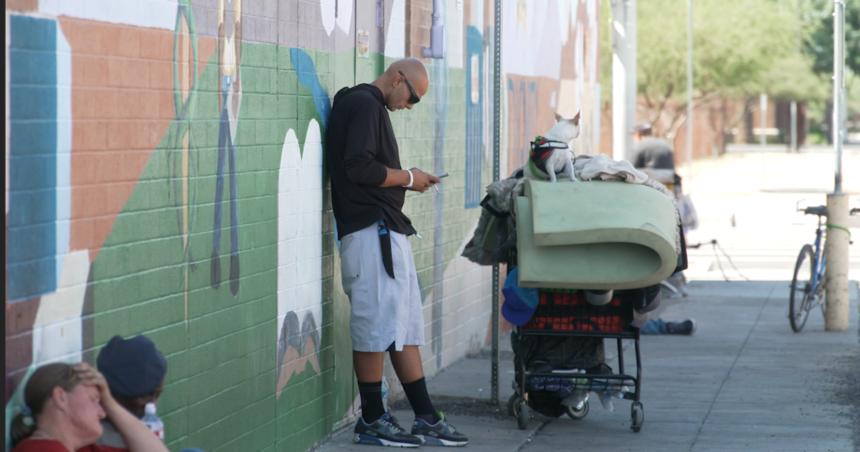Monday saw the National Weather Service announce excessive heat warnings in certain parts of California, with more warnings set to go into effect in Phoenix and Las Vegas later in the week. The soaring triple-digit temperatures offer a preview of what may come this summer, following the record-breaking heat seen in 2023, which was linked to thousands of heat-related deaths in the United States.
June 3, 2024, marked seven consecutive days of triple-digit heat in Phoenix, with the city expected to reach 110 degrees by Wednesday and 113 degrees by Thursday, prompting heat alerts.
Every year, the scorching heat engulfs the streets of Phoenix, and for homeless individuals like Ronald Kalt, securing shelter can be a challenge due to long waitlists.
“I consider myself very lucky,” said Kalt, a 67-year-old who found refuge at St. Vincent de Paul, a nonprofit in Phoenix, last May after exhausting his funds on hotels and living in his vehicle for a couple of weeks.
“The cost of housing nowadays is exorbitant… it’s beyond belief,” Kalt added.
With the median rent in Phoenix standing at $1,962 and the average rent in Arizona reaching $1,499 in March, housing affordability remains a pressing issue as summer approaches. In 2023, Maricopa County Justice Courts reported over 83,000 eviction filings, the second-highest number in a decade.
Kalt emphasized the challenges of finding housing on a fixed income without government assistance, shedding light on the struggle faced by many Arizona residents.
A homeless census conducted on January 22, 2024, in Maricopa County revealed that 9,435 individuals were experiencing homelessness, with 57% in shelters or transitional housing and 43% on the streets.
Amidst the scorching conditions, Kanani Hamman navigates her electric wheelchair through a downtown Phoenix area known as “The Zone,” where a few homeless individuals remain, seeking shade against scorching buildings.
Describing the heat as “penetrating” and “burning,” Hamman ensures she carries sunscreen and extra water to cope with the intense 100-degree afternoons.
According to state data, between 2012 and 2022, 922 longstanding Arizona residents succumbed to heat-related deaths, averaging around 85 per year.
As the sun beats down on Phoenix, the streets and sidewalks turn into dangerously hot surfaces. Experts warn that the pavement can reach temperatures as high as 180 degrees.
The Arizona burn center at Valleywise Health aptly named the searing pavement heat as “Streets of Fire,” where in 2022, 85 patients were hospitalized due to contact burns during June, July, and August, resulting in seven fatalities.
Analysis by The Associated Press in 2023 revealed that 2,300 death certificates during the summer months in the U.S. cited effects of excessive heat, with Arizona reporting a record 875 heat-related deaths, followed by Texas with 455 and Nevada with 226.
Maricopa County alone accounted for 645 heat-related deaths in 2023, a 52% increase from the previous year, with 45% involving homeless individuals.
This year, the Maricopa County Department of Public Health unveiled a new interactive dashboard monitoring heat-related deaths. As of June 3, 2024, two heat-related deaths were confirmed, with 42 under investigation.
John Ashley bikes through the Zone with his few personal belongings stored in a basket, cautious about seeking refuge in cooling centers due to fears of theft. He reveals his sleeping mat and water bottles used to combat the scorching sidewalks.
“Extreme heat is probably the most deadly weather disaster that we have,” remarked Climate Central’s chief program officer, Andrew Pershing.
A recent study by Climate Central highlighted that climate change has added almost a month of extra exposure to extreme heat for the average person, suggesting another blistering summer ahead.
To address the lethal heat, Arizona Governor Katie Hobbs introduced the state’s first Extreme Heat Preparedness Plan, outlining goals to enhance heat relief efforts, including the expansion of cooling centers and housing options, as well as emergency response updates.
St. Vincent de Paul launched the “100 Days of Summer” campaign at the end of May, focusing on providing essential items like water, food, and shelter to those in need.
Berg expresses concerns about the sustainability of increased heat-relief efforts as funding from pandemic-era federal sources is expected to diminish.
Dr. Eugene Livar, Arizona’s first Chief Heat Officer, mentioned the state’s intention to seek grants once existing funding streams dry up.
Furthermore, the Biden administration introduced a heat and health index to assist communities in preparing for extreme heat events and to empower city leaders with vital data for decision-making.
After a year at St. Vincent de Paul, Kalt is finally transitioning into a more permanent residence, emphasizing the need for more accessible shelters for those in need.





